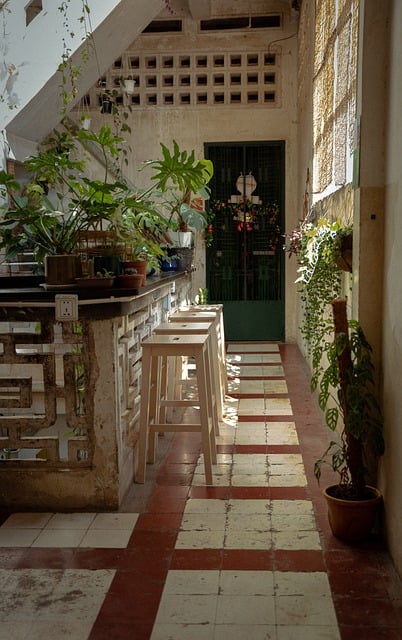Embark on the fascinating journey of landscaping and creating a unique garden space that reflects your personal style.
You might find yourself grappling with myriad options, styles, and influences. This exciting realm blends artistic aesthetics with practicality, transforming ordinary outdoor spaces into extraordinary havens where nature meets nurture.
From understanding the basics of landscaping to defining specific sections as garden rooms, this immersive guide will give you insights, tips, and ideas to shape your vision.
Design Principles Overview
To start any landscaping project, you first need to grasp the foundations of design principles. These concepts include unity, balance, proportion, focalization, sequence, rhythm, repetition, and simplicity. Each adds a different layer to your landscape design and helps connect all the elements cohesively.
Choosing Your Garden Room Style
Opt for a style that resonates with your personality – an extension of your indoor living space that seamlessly blends in yet stands apart due to its distinctive character.
Site Considerations and Limitations
The orientation of sunlight plays a pivotal role in deciding what kind of plants will flourish best in specific spaces.
Climate and Maintenance Factors
Select plants native or suited to your local climate akin (Colorado Springs Landscaping is a useful resource for regional guidance). Also, consider their maintenance demands according to your schedule and availability.
Environment and Space Analysis
Before making any decisions about your landscape’s design, it’s essential to examine the environment of the area thoroughly.
Study the natural lay of the land – understand how sunlight falls on different parts of your lawn at various times of day. Take into account any existing vegetation or significant features that can either aid or constrain your plan.
Establishing Harmony in Landscaping
Proper use of color sets the mood in your landscapes. Warm hues like yellows and reds tend to grab attention while cool tones like blues and greens invoke tranquility.
By understanding how colors impact emotions, you can use them strategically to evoke specific feelings within varied sections of the landscape.
Plant Textures and Forms
Besides color, different plant shapes and textures dramatically influence a garden’s overall ambiance. Broad-leaved plants lend a robust characteristic whereas needle-leaved ones introduce delicacy. Remember to mix these judiciously for an engaging visual experience.
Sizing and Spacing Methodology
The right balance between plant sizes provides perspective while adequate spacing allows each one room to thrive without competing for nutrients.
Garden Room Inspirations
There are many benefits to a conservatory or garden room. Added value and functionality are just two of the gains.
Classic English Garden Rooms
Immaculate lawns segmenting flowerbeds flourishing with hydrangeas, and delphiniums attracting butterflies swirling around a central water feature – classic English garden rooms are renowned for their attention to detail.
Modern Minimalist Garden Spaces
Sleek lines define minimalist landscapes with monochromatic palettes accentuated by aesthetic lighting arrangements.
Exotic Tropical Garden Oasis
Lush foliage combined with vibrant blossoms captures attention swiftly in these themed gardens inspired by exotic global destinations.
Creating Your Garden Room
Plan out your garden room layout – a good method is using grids on sketch paper. Remember not to overlook spaces like corners – they hold great opportunities for creative expression.
Choose flora according to their growth patterns – opt for annuals for adding instant color while considering perennials for long-term green coverage.
Think beyond plants! A beautifully designed bench or an intriguing sculpture could become the signature piece within your garden room.
Accessorizing Your Landscaped Garden
The use of garden furniture and features will add character to your backyard. Certain plants will bring more wildlife to your garden including butterflies and birds too.
Use of Water Elements:
The addition of water elements like fountains or ponds elevates the aesthetics while bringing a tranquil soundtrack – the sound of dripping or flowing water brings an alluring ambiance unmatched by other add-ons.
Lighting for Ambiance
Strategically placed lights can emphasize particular areas within your landscape; they enhance visibility after sunset while adding dramatic visual interest.
Decorative Features Selection
Opt for decorative features that reinforce your chosen theme or make an otherwise muted section “pop”!
Maintaining Your Landscaped Garden
Regular trimming helps maintain shape while ensuring optimal access to sunlight.
Seasonal Care Requirements
Be aware of seasonal plant requirements – some need extra care during winter while others may require frequent watering during summer.
Pest and Disease Management
Keep an eye out for common garden pests or diseases that could affect plant life – early detection often enables simpler control methods.
To Summarize
As we conclude our extensive expedition through this engrossing universe – remember that designing your dream landscape is more than just a visually pleasing arrangement. It’s about integrating multiple senses harmoniously.
While highly personal preferences shape landscapes significantly, incorporating fundamentals goes a long way toward achieving stunning results. With mindfulness toward design principles comes a remarkable transformation that infuses every day spent at home with joyous interactions.

Recent Comments